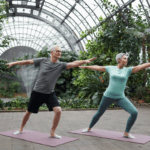Coming Soon: E-book about Kundalini Yoga - Sign up here to be among the first to get it!
Ever felt like you’re holding the weight of the world in your palms, elbows quivering as if bearing life’s burdens? That might just be your first encounter with Chaturanga Dandasana. You know it’s a staple when even yoga beginners nod in recognition. But what makes this four-limbed staff pose more than just an exercise?
Think about it—every time you hover above your mat, there’s a surge of strength coursing through you, isn’t there? This key player weaves into sun salutations like threads in fabric, building not only muscle but discipline.
You’re probably asking yourself how such a challenging pose can feel so empowering once mastered. Well, that’s exactly where we’re headed! Dive deep with me and by the end of our journey together; core engaged, shoulders steady—you’ll transform from shaky to rock-solid.
Table of Contents:
- Understanding Chaturanga Dandasana
- The Versatility of Chaturanga Dandasana Across Yoga Styles
- Health Benefits of Mastering Four-Limbed Staff Pose
- Safety First – Contraindications for Chaturanga Dandasana
- Step-by-Step Guide to Perfecting Chaturanga Dandasana
- FAQs in Relation to Chaturanga Dandasana
- Conclusion
Understanding Chaturanga Dandasana
The four-limbed staff pose, known as Chaturanga Dandasana in Sanskrit, is more than just a transition. It’s the backbone of many flows and key poses within yoga practice. As an experienced yoga teacher and devoted practitioner, I have come to admire the intricacy of Chaturanga Dandasana (the four-limbed staff pose in Sanskrit) and its importance for developing strength across various forms of yoga.
Sanskrit Roots and Meaning
In breaking down ‘Chaturanga Dandasana,’ we uncover layers that give us insight into this foundational posture. ‘Chatur’ translates to ‘four,’ while ‘Anga’ means limb; combined with ‘Danda,’ meaning staff or rod—a symbol of stability—and finally ‘Asana,’ which refers to pose or seat. Thus, we arrive at an understanding: This challenging pose mimics a sturdy yet dynamic support structure held up by our limbs.
Frequently nestled within sun salutation sequences, mastering Chaturanga demands more than muscular effort—it requires finesse in alignment points too. When done correctly, it forms a straight body line from your heels pressing back through your head pushing forward—resembling not just any staff but one perfectly balanced on all sides.
Core Position in Yoga Flows
This powerful plank position acts as an essential bridge between postures like facing dog (Adho Mukha Svanasana) and upward-facing dog (Urdhva Mukha Svanasana). Whether you’re flowing through Vinyasa sequences or engaging in Ashtanga’s Sun Salutation B sequence—the integrity of your four-limbed staff pose can either powerfully propel you forward or leave gaps that might hinder progress toward advanced arm balances later on.
To maintain proper chaturanga alignment when transitioning from plank pose is vital for preserving shoulder health—an area often compromised if shoulders dip below elbows level during this weight-bearing challenge.
The Versatility of Chaturanga Dandasana Across Yoga Styles
Different styles like Power Yoga ask practitioners to hold their limbed-staff longer for extra heat-building benefits whereas Ashtangis integrate it repeatedly throughout their rigorous series—each approach tailoring the intensity accordingly but always emphasizing strong core engagement with elbows close against ribs keeping upper arms parallel at ninety degrees angle over wrists grounded firmly beneath them thus creating full-body tension akin tunneling through resistance purposefully built along these energetic lines ensuring every downward press feeds directly into next uplift cycle rhythmically consistent amidst ever-changing flow states capturing essence what being truly present moment entails no matter varied approaches converge upon same fundamental truth needing sustain said form securely without wavering until cue signals otherwise release onwards towards whatever awaits next phase journey…
Chaturanga Dandasana, the four-limbed staff pose, is crucial in yoga—not just a transition but also a builder of strength and stability. Its Sanskrit name reflects its role as a supportive structure. Mastering it means aligning your body into one straight line from head to heels and keeping your shoulders above elbow level to protect them during this weight-bearing challenge.
Different yoga styles may vary how long you hold Chaturanga or how often it’s integrated, yet all emphasize core engagement and proper form. Maintaining alignment not only builds heat but also sets you up for success in more advanced poses.
The Versatility of Chaturanga Dandasana Across Yoga Styles
Chaturanga Dandasana, often hailed as the four-limbed staff pose, is more than just a step in your yoga flow. It’s a bridge between worlds—melding strength with serenity across different styles like Vinyasa and Ashtanga.
Sanskrit Roots and Meaning
In Sanskrit, ‘Chatur’ means four, ‘Anga’ translates to limb, and ‘Danda’ stands for staff. The name itself sketches an image of stability—a human form hovering parallel above the earth supported by only hands and toes. A core element within sun salutation sequences, it lays down roots deep into yoga’s heritage.
When we weave this posture through our movements in class or solo practice at home, we’re tapping into ancient tradition. This isn’t merely about holding your weight; it’s about embracing balance—the essence that gives life to every sun salutation sequence you flow through.
Core Position in Yoga Flows
In dynamic vinyasa flows where breath syncs with movement like an intimate dance partner, chaturanga dandasana takes center stage. You’ll find yourself gliding from plank pose into this foundational hold before sweeping up into upward-facing dog—or rolling over your toes straight back to downward-facing dog—and feeling how seamlessly chaturanga binds these key poses together.
We’ve all felt that burn building strength in our upper body while keeping elbows close during transitions; but remember—maintaining proper alignment ensures not just muscle gain but also longevity on the mat.
Versatility Across Practices: Vinyasa vs Power vs Ashtanga Namaskara
Different schools put their spin on this versatile pose:
- In vinyasa yoga classes, a fluid motion reigns supreme;
- Power yoga turns up the intensity dial for those looking to build even more muscular effort;
- Ashtanga namaskara honors tradition by embedding chaturanga firmly within its Sun Salutation B series—proof of its timeless stature among practitioners who value precision alongside power.
No matter which class you step foot in—from a cozy neighborhood studio offering gentle hathas right up to bustling gyms echoing with shouts of encouragement—you’ll see bodies pausing mid-air as if suspended by invisible strings thanks to chaurtunga dandansa’s ubiquitous presence.
Chaturanga Dandasana isn’t just a pose; it’s the heart of many yoga flows, bridging power and calm across styles like Vinyasa to Ashtanga. It draws from ancient roots for balance and seamlessly connects key movements, showing its versatility in every class you join.
Health Benefits of Mastering Four-Limbed Staff Pose
It’s more than just a transition pose; it’s a powerhouse for building strength and stability. Let me break down how this four-limbed staff pose can supercharge your practice.
Sanskrit Roots and Meaning
The name itself comes from Sanskrit where “Chatur” means four, “Anga” is limbed, and “Danda” translates to staff. Think of your body as a strong staff held up by four sturdy limbs—a visual that captures both the form and fortitude required in Chaturanga Dandasana.
Core Position in Yoga Flows
This isn’t just another posture; it’s key to many flows like Sun Salutation sequences. By regularly weaving Chaturanga into your practice, you get fluent in transitioning smoothly through poses—an essential skill for dynamic styles like Vinyasa or Ashtanga.
Strengthens upper arm muscles including serratus anterior, pectoralis major;
Learn about maintaining proper alignment throughout your body during Chaturanga Dandasana at Yoga Journal.
Versatility Across Yoga Styles
Different schools of yoga bring their unique spin on this classic move: In Power Yoga sessions,this becomes an intense exercise for endurance, while traditionalists might emphasize its role within Sun Salutation B series specific to Ashtanga practices.
The bottom line? Whether fast-paced or methodical—the benefits rack up regardless.
Chaturanga Dandasana isn’t just a transitional pose; it’s crucial for building strength and stability, key to smooth transitions in dynamic yoga styles, and awesome for strengthening the upper arms and core. Plus, it rocks across various yoga practices.
Safety First – Contraindications for Chaturanga Dandasana
When we talk about building strength in yoga, Four-Limbed Staff Pose often takes the spotlight. But it’s crucial to approach this powerful pose with caution, especially if you’re dealing with shoulder injuries or wrist pain. Your safety is paramount because doing Chaturanga incorrectly can increase your risk of exacerbating these issues.
Shoulder Injuries and Chaturanga Dandasana
The intricate network of muscles and tendons around the shoulder joint makes it exceptionally vulnerable during weight-bearing poses like Chaturanga Dandasana. If there’s a history of rotator cuff injuries or instability, misalignment in this pose could spell trouble. So let me break it down: when practicing Chaturanga, ensure that your elbows are stacked directly over wrists and keep those elbows close to your body to protect the shoulders.
If you’ve got any nagging doubts about an old injury flaring up again—listen to that intuition. It might be worth chatting with a yoga teacher who can help tailor modifications just for you; think plank position as a starting point before slowly easing into more advanced variations.
Navigating Wrist Pain During Practice
We need our wrists healthy not just on the mat but off it too. Bearing weight on hands may contribute to wrist pain or conditions like carpal tunnel syndrome where nerves get all squished up leading to numbness and tingling sensations—a real no-go.
To sidestep potential discomfort while holding chaturanga dandasana, press firmly through knuckles rather than dumping all pressure onto heels of hands which lets some air into those tight spaces within carpal tunnels—and hey presto. You’ve found relief without having sacrificed practice time.
Carpal Tunnel Syndrome Considerations
A discussion about wrist health wouldn’t be complete without mentioning carpal tunnel syndrome (CTS). This sneaky condition creeps up due largely from repetitive motions—or maintaining challenging poses like four-limbed staff pose—for lengthy periods.
Did you know folks experiencing CTS face higher risks performing postures requiring extensive flexion at wrists? That’s why proper alignment points matter heaps; they’re key factors ensuring forearms remain parallel thus reducing unnecessary strain on nerve passageways.
For yogis living life alongside CTS consider adopting forearm plank instead—it gives same core-engaged perks minus undue stress placed upon delicate wrist joints.
Remember friends: always listen closely to what your body whispers (or shouts.) about comfort levels throughout every single yoga flow sequence. Be alert to the communication from your body, and modify your movements as necessary; this will ensure you are secure while making the most of your yoga session.
Chaturanga Dandasana demands respect for your body’s limits, especially with shoulder or wrist issues. Keep elbows over wrists and tight to the body, press through knuckles not palms, and consider forearm plank to dodge discomfort. Listen to your body—modifications are your friends.
Step-by-Step Guide to Perfecting Chaturanga Dandasana
Known as Four-Limbed Staff Pose or simply ‘Chaturanga’, it’s like a plank got serious about building strength and tone across your upper body.
Sanskrit Roots and Meaning
Dive deep into its Sanskrit roots, and you’ll find ‘chatur’ means four, ‘anga’ is limbed, and ‘danda’ translates to staff. This pose mirrors the stability of a staff held by your entire body – that’s right; we’re talking arms straight but elbows close in this powerful pose.
The essence of Chaturanga Dandasana lies in its foundational role within dynamic sequences such as Sun Salutations. It requires strength not just from one part but demands full-body engagement – from shoulder blades down to heels press firmly against an invisible wall behind you.
Core Position in Yoga Flows
In vinyasa flows, transitioning through Chaturanga can feel like dancing with gravity – it’s smooth yet challenging. The beauty? Each style adapts it uniquely. Vinyasa yoga often employs this posture for building heat while Ashtangis might incorporate it more rigorously within their Sun Salutation B sequence.
Moving fluidly between poses involves muscular effort where alignment points matter big time because they help us avoid injuries like shoulder issues or wrist pain common among beginners who haven’t nailed proper form yet.
A Stepwise Breakdown To Nail Your Form
- Breathe In: From Plank Pose (also known as High Push-Up), make sure your shoulders stay stacked directly over wrists—no cheating forward or back.
- Breathe Out: Engage those core muscles. Think about creating a straight line with your body from head-to-toe without letting hips sag or pop up.
- Breathe In Again: Start bending elbows backward alongside ribcage maintaining them at roughly ninety-degree angle relative to forearms making sure not to let them wing out wide.
- Last Breath Out: Hover above ground level keeping everything tight including thighs which should be lifted too unless doing modified version on knees.
- Hold On Tight:
Note: You’ve made it here – now take a deep breath, letting that energy flow through you. Plant your palms firmly and glide seamlessly into Urdhva Mukha Svanasana.
Chaturanga Dandasana is more than a plank; it’s a full-body workout that builds serious strength. Dive into its Sanskrit roots, and you’ll see why: “four-limbed staff” reflects the pose’s solid stability. Remember, proper form is key—keep elbows in and push heels back to avoid injuries.
FAQs in Relation to Chaturanga Dandasana
What are the benefits of Chaturanga Dandasana?
This pose boosts arm and core strength, stabilizes shoulders, and preps your body for advanced yoga moves.
What is the difference between chaturanga and Chaturanga Dandasana?
‘Chaturanga’ often means just the plank part; ‘Dandasana’ adds holding the low push-up position to nail it fully.
How do you do Chaturanga Dandasana?
To ace this move: start in a high plank, then lower halfway keeping elbows tight. Hold strong right above ground level.
What is the difference between chaturanga and Vinyasa?
Vinyasa’s a flow sequence including poses like chaturanga. Think of chaturangas as building blocks within a vinyasa routine.
Conclusion
Chaturanga Dandasana is a foundation, a building block. It’s strength and stability rolled into one grounded posture. We’ve journeyed through its origins, understood how it threads through sun salutations, across yoga styles.
Remember this: core engaged; elbows close to the body; shoulders far from ears—these are your mantras for safe practice. Let them echo in every muscle memory.
Your arms might shake at first—that’s normal—but they will become pillars of power with time and dedication. And while injury can loom where alignment strays, stay mindful of form to keep harm at bay.
Now take these lessons off the mat. Chaturanga Dandasana teaches resilience beyond poses—it’s about bearing life’s weight without faltering, turning challenge into unwavering confidence.
Sign up for our newsletter to stay updated with the latest articles, or ask me anything!



